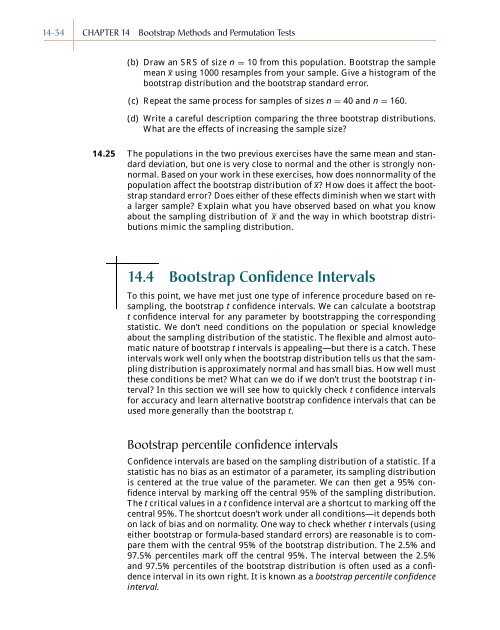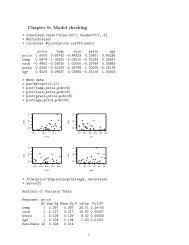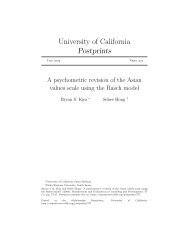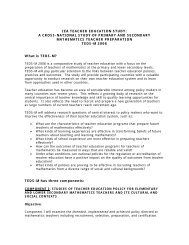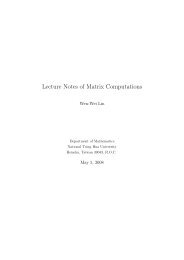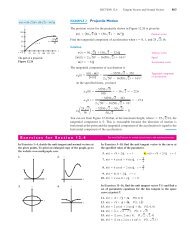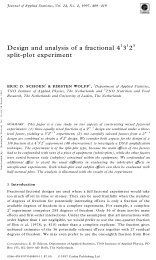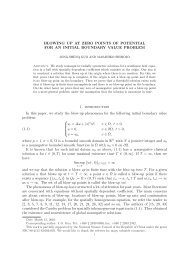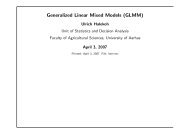Chapter 14 - Bootstrap Methods and Permutation Tests - WH Freeman
Chapter 14 - Bootstrap Methods and Permutation Tests - WH Freeman
Chapter 14 - Bootstrap Methods and Permutation Tests - WH Freeman
You also want an ePaper? Increase the reach of your titles
YUMPU automatically turns print PDFs into web optimized ePapers that Google loves.
<strong>14</strong>-34 CHAPTER <strong>14</strong> <strong>Bootstrap</strong> <strong>Methods</strong> <strong>and</strong> <strong>Permutation</strong> <strong>Tests</strong><br />
(b) Draw an SRS of size n = 10 from this population. <strong>Bootstrap</strong> the sample<br />
mean x using 1000 resamples from your sample. Give a histogram of the<br />
bootstrap distribution <strong>and</strong> the bootstrap st<strong>and</strong>ard error.<br />
(c) Repeat the same process for samples of sizes n = 40 <strong>and</strong> n = 160.<br />
(d) Write a careful description comparing the three bootstrap distributions.<br />
What are the effects of increasing the sample size?<br />
<strong>14</strong>.25 The populations in the two previous exercises have the same mean <strong>and</strong> st<strong>and</strong>ard<br />
deviation, but one is very close to normal <strong>and</strong> the other is strongly nonnormal.<br />
Based on your work in these exercises, how does nonnormality of the<br />
population affect the bootstrap distribution of x? How does it affect the bootstrap<br />
st<strong>and</strong>ard error? Does either of these effects diminish when we start with<br />
a larger sample? Explain what you have observed based on what you know<br />
about the sampling distribution of x <strong>and</strong> the way in which bootstrap distributions<br />
mimic the sampling distribution.<br />
<strong>14</strong>.4 <strong>Bootstrap</strong> Confidence Intervals<br />
To this point, we have met just one type of inference procedure based on resampling,<br />
the bootstrap t confidence intervals. We can calculate a bootstrap<br />
t confidence interval for any parameter by bootstrapping the corresponding<br />
statistic. We don’t need conditions on the population or special knowledge<br />
about the sampling distribution of the statistic. The flexible <strong>and</strong> almost automatic<br />
nature of bootstrap t intervals is appealing—but there is a catch. These<br />
intervals work well only when the bootstrap distribution tells us that the sampling<br />
distribution is approximately normal <strong>and</strong> has small bias. How well must<br />
these conditions be met? What can we do if we don’t trust the bootstrap t interval?<br />
In this section we will see how to quickly check t confidence intervals<br />
for accuracy <strong>and</strong> learn alternative bootstrap confidence intervals that can be<br />
used more generally than the bootstrap t.<br />
<strong>Bootstrap</strong> percentile confidence intervals<br />
Confidence intervals are based on the sampling distribution of a statistic. If a<br />
statistic has no bias as an estimator of a parameter, its sampling distribution<br />
is centered at the true value of the parameter. We can then get a 95% confidence<br />
interval by marking off the central 95% of the sampling distribution.<br />
The t critical values in a t confidence interval are a shortcut to marking off the<br />
central 95%. The shortcut doesn’t work under all conditions—it depends both<br />
on lack of bias <strong>and</strong> on normality. One way to check whether t intervals (using<br />
either bootstrap or formula-based st<strong>and</strong>ard errors) are reasonable is to compare<br />
them with the central 95% of the bootstrap distribution. The 2.5% <strong>and</strong><br />
97.5% percentiles mark off the central 95%. The interval between the 2.5%<br />
<strong>and</strong> 97.5% percentiles of the bootstrap distribution is often used as a confidence<br />
interval in its own right. It is known as a bootstrap percentile confidence<br />
interval.


